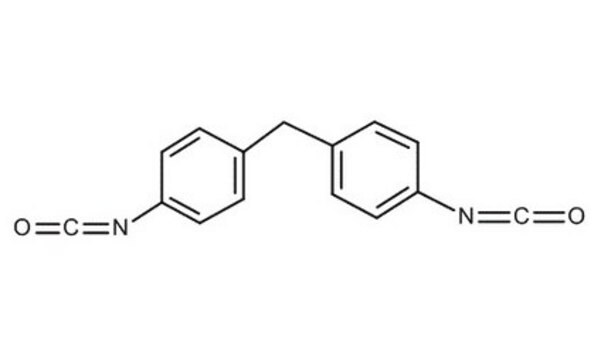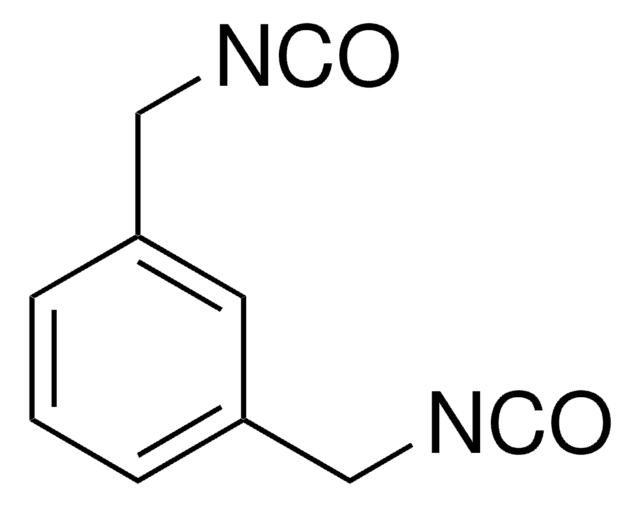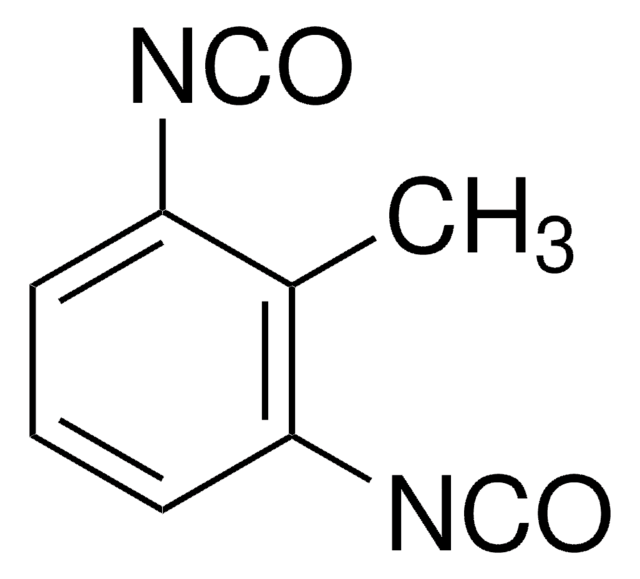256439
4,4′-Methylenebis(phenyl isocyanate)
98%
Sinónimos:
4,4′-MDI, Bis(4-isocyanatophenyl)methane
About This Item
Productos recomendados
Nivel de calidad
Ensayo
98%
Formulario
solid
idoneidad de la reacción
reagent type: cross-linking reagent
bp
200 °C/5 mmHg (lit.)
mp
42-45 °C (lit.)
densidad
1.18 g/mL at 25 °C (lit.)
temp. de almacenamiento
−20°C
cadena SMILES
O=C=Nc1ccc(Cc2ccc(cc2)N=C=O)cc1
InChI
1S/C15H10N2O2/c18-10-16-14-5-1-12(2-6-14)9-13-3-7-15(8-4-13)17-11-19/h1-8H,9H2
Clave InChI
UPMLOUAZCHDJJD-UHFFFAOYSA-N
¿Está buscando productos similares? Visita Guía de comparación de productos
Categorías relacionadas
Descripción general
Aplicación
- Polyurethane cationomers, that are applicable in medical implants.
- A prepolymer for preparing self-healable polyurethane elastomers.
Palabra de señalización
Danger
Frases de peligro
Consejos de prudencia
Clasificaciones de peligro
Acute Tox. 4 Inhalation - Carc. 2 - Eye Irrit. 2 - Resp. Sens. 1 - Skin Irrit. 2 - Skin Sens. 1 - STOT RE 2 Inhalation - STOT SE 3
Órganos de actuación
Respiratory system
Código de clase de almacenamiento
11 - Combustible Solids
Clase de riesgo para el agua (WGK)
WGK 1
Punto de inflamabilidad (°F)
411.8 °F - closed cup
Punto de inflamabilidad (°C)
211 °C - closed cup
Equipo de protección personal
dust mask type N95 (US), Eyeshields, Faceshields, Gloves
Listados normativos
Los listados normativos se proporcionan para los productos químicos principalmente. Para los productos no químicos sólo se puede proporcionar información limitada. Si no hay ninguna entrada, significa que ninguno de los componentes está en la lista. Es obligación del usuario garantizar el uso seguro y legal del producto.
EU REACH Annex XVII (Restriction List)
Elija entre una de las versiones más recientes:
¿Ya tiene este producto?
Encuentre la documentación para los productos que ha comprado recientemente en la Biblioteca de documentos.
Los clientes también vieron
Global Trade Item Number
| Número de referencia del producto (SKU) | GTIN |
|---|---|
| 256439-10KG | |
| 256439-500G | 4061826058138 |
| 256439-50G | 4061826058145 |
| 256439-5KG | 4061833605783 |
Nuestro equipo de científicos tiene experiencia en todas las áreas de investigación: Ciencias de la vida, Ciencia de los materiales, Síntesis química, Cromatografía, Analítica y muchas otras.
Póngase en contacto con el Servicio técnico











